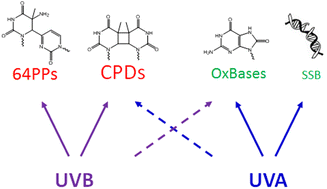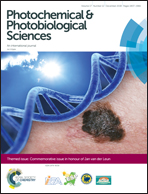Formation of UV-induced DNA damage contributing to skin cancer development†
Abstract
UV-induced DNA damage plays a key role in the initiation phase of skin cancer. When left unrepaired or when damaged cells are not eliminated by apoptosis, DNA lesions express their mutagneic properties, leading to the activation of proto–oncogene or the inactivation of tumor suppression genes. The chemical nature and the amount of DNA damage strongly depend on the wavelength of the incident photons. The most energetic part of the solar spectrum at the Earth's surface (UVB, 280–320 nm) leads to the formation of cyclobutane pyrimidine dimers (CPDs) and pyrimidine (6–4) pyrimidone photoproducts (64PPs). Less energetic but 20–times more intense UVA (320–400 nm) also induces the formation of CPDs together with a wide variety of oxidatively generated lesions such as single strand breaks and oxidized bases. Among those, 8–oxo–7,8–dihydroguanine (8–oxoGua) is the most frequent since it can be produced by several mechanisms. Data available on the respective yield of DNA photoproducts in cells and skin show that exposure to sunlight mostly induces pyrimidine dimers, which explains the mutational signature found in skin tumors, with lower amounts of 8–oxoGua and strand breaks. The present review aims at describing the basic photochemistry of DNA and discussing the quantitative formation of the different UV–induced DNA lesions reported in the literature. Additional information on mutagenesis, repair and photoprotection is briefly provided.

- This article is part of the themed collections: Commemorative issue in honour of Jan van der Leun and 2018 Perspective article collection


 Please wait while we load your content...
Please wait while we load your content...